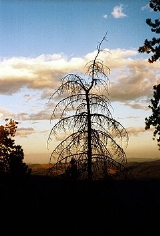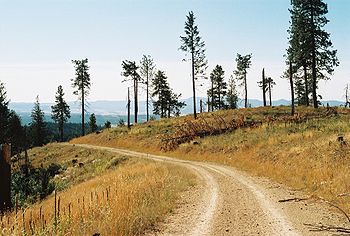
Virgil T. McCroskey
Encyclopedia
Virgil Talmadge McCroskey (October 5, 1876 – September 14, 1970) was an American conservationist who spent most of his life in Eastern Washington. He created two state parks: Steptoe Butte State Park
in Washington State and McCroskey State Park
in Idaho
.
and in 1903 purchased the Elk Drug Store in Colfax, Washington
, the facade of which still bears his name. Although he never married, during this period he raised two orphaned nieces and a nephew. McCroskey inherited his parents' farm in 1910 and retired from the pharmacy business in 1920. He spent the next few years traveling the world; he also drove all over the West, visiting national parks.
and locally famous for the view from the top. Steptoe Butte State Park was dedicated on July 4, 1946, becoming Washington's 72nd state park. In 1965, at a ceremony declaring Steptoe Butte a National Natural Landmark
, McCroskey was the guest of honor.
Once this project was completed, McCroskey turned his attention to preserving Skyline Ridge, an area of old-growth forest just over the border in Benewah County, Idaho
which was increasingly threatened by logging. In 1951, after he had accumulated 2000 acres (8.1 km²), he began trying to gift the land to Idaho for a state park. The Idaho legislature, however, was unenthusiastic, thinking that the park would not generate enough tourist revenue to pay for the park's upkeep and to make up for the loss to the tax rolls. McCroskey did not give up. He added 2400 acres (9.7 km²) more to the parcel over the next three years and on August 7, 1955, after McCroskey, then 79 years old, agreed to maintain the park at his own expense for the next fifteen years, Mary Minerva McCroskey State Park finally became a reality.
McCroskey lived fifteen more years - almost exactly long enough to fulfill his obligation to the state of Idaho. He continued improving the park (often working with his own hands) until shortly before his death at the age of 93.

 Steptoe Butte State Park, an easily accessed and highly visible landmark, receives many visitors, most of whom simply drive to the top to enjoy the view for a few minutes. McCroskey State Park, however, despite its larger size and much greater recreational opportunities, has long been neglected and underutilised. In recent years, however, the situation has begun to change as more people become aware of the park's abundant wildlife, beautiful scenery, and thirty miles of trails.
Steptoe Butte State Park, an easily accessed and highly visible landmark, receives many visitors, most of whom simply drive to the top to enjoy the view for a few minutes. McCroskey State Park, however, despite its larger size and much greater recreational opportunities, has long been neglected and underutilised. In recent years, however, the situation has begun to change as more people become aware of the park's abundant wildlife, beautiful scenery, and thirty miles of trails.
Steptoe Butte
Steptoe Butte is a quartzite island jutting out of the silty loess of the Palouse hills in Whitman County, Washington. It is contained by Steptoe Butte State Park. The rock that forms the butte is over 400 million years old, in contrast with the 15–7 million year old Columbia River basalts that...
in Washington State and McCroskey State Park
McCroskey State Park
McCroskey State Park is a state park of Idaho, USA, stretching along a ridge in the Palouse region. At this wilderness area is Idaho's second-largest state park...
in Idaho
Idaho
Idaho is a state in the Rocky Mountain area of the United States. The state's largest city and capital is Boise. Residents are called "Idahoans". Idaho was admitted to the Union on July 3, 1890, as the 43rd state....
.
Early years
Virgil Talmadge McCroskey was the ninth of ten children born to Joshua Philander and Mary Minerva McCroskey, who settled in Eastern Washington as pioneers and established a homestead near the foot of Steptoe Butte. McCroskey earned a degree in pharmacy at Washington State UniversityWashington State University
Washington State University is a public research university based in Pullman, Washington, in the Palouse region of the Pacific Northwest. Founded in 1890, WSU is the state's original and largest land-grant university...
and in 1903 purchased the Elk Drug Store in Colfax, Washington
Colfax, Washington
Colfax is the county seat of Whitman County, Washington, United States.The population was 2,805 at the 2010 census.It is situated amidst wheat-covered hills in a valley at the confluence of the north and south forks of the Palouse River. U.S...
, the facade of which still bears his name. Although he never married, during this period he raised two orphaned nieces and a nephew. McCroskey inherited his parents' farm in 1910 and retired from the pharmacy business in 1920. He spent the next few years traveling the world; he also drove all over the West, visiting national parks.
Conservation activities
When McCroskey returned from his travels, he at first contented himself with planting trees and flowers to beautify the family farm. Soon, however, he began a second career as an amateur conservationist, using his money and energies to cobble together parcels of land for two new state parks. Eventually, he sold his farm to raise revenue and moved to nearby Oakesdale. He first focused his efforts on Steptoe Butte, an island of ancient rock rising high above the surrounding palouse countryPalouse
The Palouse is a region of the northwestern United States, encompassing parts of southeastern Washington, north central Idaho and, in some definitions, extending south into northeast Oregon. It is a major agricultural area, primarily producing wheat and legumes...
and locally famous for the view from the top. Steptoe Butte State Park was dedicated on July 4, 1946, becoming Washington's 72nd state park. In 1965, at a ceremony declaring Steptoe Butte a National Natural Landmark
National Natural Landmark
The National Natural Landmark program recognizes and encourages the conservation of outstanding examples of the natural history of the United States. It is the only natural areas program of national scope that identifies and recognizes the best examples of biological and geological features in...
, McCroskey was the guest of honor.
Once this project was completed, McCroskey turned his attention to preserving Skyline Ridge, an area of old-growth forest just over the border in Benewah County, Idaho
Benewah County, Idaho
Benewah County is a county located in the U.S. state of Idaho. Established on January 23, 1915, from sections of Kootenai County, it was named for a chief of the Coeur d'Alene Tribe. As of the 2010 census the county had a population of 9,285. The county seat and largest city is St...
which was increasingly threatened by logging. In 1951, after he had accumulated 2000 acres (8.1 km²), he began trying to gift the land to Idaho for a state park. The Idaho legislature, however, was unenthusiastic, thinking that the park would not generate enough tourist revenue to pay for the park's upkeep and to make up for the loss to the tax rolls. McCroskey did not give up. He added 2400 acres (9.7 km²) more to the parcel over the next three years and on August 7, 1955, after McCroskey, then 79 years old, agreed to maintain the park at his own expense for the next fifteen years, Mary Minerva McCroskey State Park finally became a reality.
McCroskey lived fifteen more years - almost exactly long enough to fulfill his obligation to the state of Idaho. He continued improving the park (often working with his own hands) until shortly before his death at the age of 93.
Legacy


Sources
- Reed, Mary and Petersen, Keith. Virgil T. McCroskey, Giver of Mountains. Pullman, WA: Washington State University History Department, 1983.
- Arksey, Laura. "McCroskey, Virgil Talmadge." Historylink: The Online Encyclopedia of Washington State History, Essay #7989, November 5, 2006. Full Text.
- Vogt, Andrea. "The Man Who Gave Away Mountains." Washington State Magazine, 2006 (Full Text)

